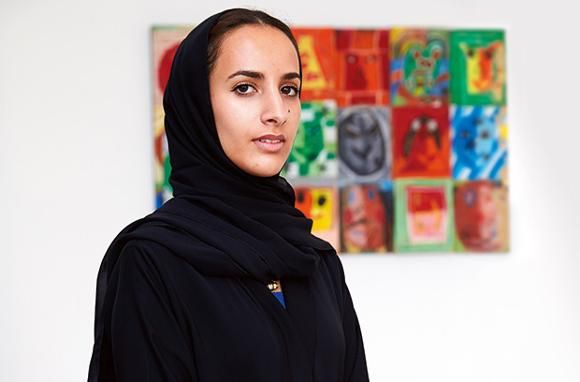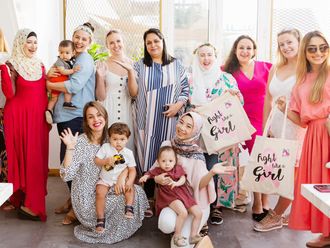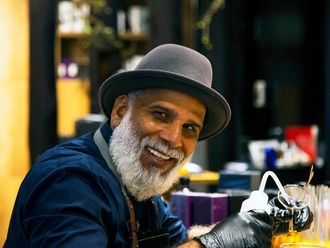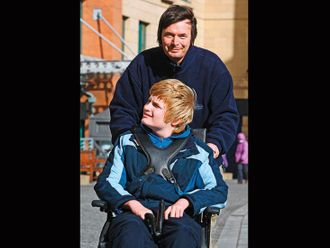
Emirati artist Dana Al Mazrouei pinned down the theme for this year’s Sharjah Children’s Biennial – A World as Big as Your Imagination – in June last year. But the seed of the idea was sown decades ago.
‘My earliest memories involve my mum, Fatima, crafting decorations and collages and carving edible animals from watermelons for my siblings and me. No wall was free of some kind of home-made art and if it was empty, and I’d come by a pencil, then that space would instantly be filled with drawings,’ she reminisces. ‘Obviously I got punished for it,’ she shrugs, ‘but I still had the freedom to do it, to be creative.’
When Dana, 29, last year accepted the curatorship of the fifth Sharjah Children’s Biennial (SBC), which runs until February 15, it was this freedom ‘to dream, build ideas and have thoughts’, that she wanted the participants, children aged six to 18 years, to enjoy.
‘I’d seen the other editions and wondered how or what I could do to top the high standards they’ve maintained. Then I remembered a Sharjah government initiative I absolutely loved, Create your City.’ Combined, it all boiled down to ‘a world as big as your imagination’.
‘I wanted the kids to realise they’re part of this world, and imagination is what should build the world.’
Dana is a poster child for the influence and importance art can and does exert on young minds.
While her weekends at home involved getting down and arty constructing sandcastles (structures were added every week) with her siblings under the supervision of their architect-engineer uncle, her weekdays at the Latifa School for Girls in Dubai were artistic theoretically – poring over art books and images of classic oeuvres. She says the school has one of the strongest art-centric British curricula in the UAE.
‘My foundation in art began there. When I started travelling and visiting museums as a grown up it was déjà vu – didn’t I do this in grade 3, didn’t I study this in grade 4?’ she says with a laugh.
Dana is one of a crop of Emirati artists who are culturally rooted here but are spreading their wings abroad. Her attire – a chic pencil skirt and top veiled by an abaya – reflects her cosmopolitan outlook and perspective, as does her academic career. She pursued Art History and Museum Studies at Sorbonne Abu Dhabi after winning the Shaikh Mohammad Bin Zayed Scholarship, followed by international work placements at major organisations like the Louvre and Centre Pompidou in Paris.
Along the way, word of Dana’s artisanship got around and she was commissioned to execute several prestigious projects: designing the cover of a 2011 book of poetry by His Highness Shaikh Mohammad Bin Rashid Al Maktoum, Vice President and Prime Minister of the UAE and Ruler of Dubai; and painting the 89th floor of the Burj Khalifa.
She was one of the three pivotal artists featured in Three Generations, an exhibition charting the UAE’s art scene at Sotheby’s London, eventually culminating in nabbing a day job as art museum educator at the Abu Dhabi Culture and Tourism Authority.
Painting the walls of the world’s tallest building must have her feeling on top of the world, I say. All I get in response is a Mona Lisa smile. Those months of training with the head of arts education at the Louvre have paid off in more ways than one.
Then she launches into an anecdote about installations she created for the Shaikha Salama Bint Hamdan Al Nahyan Foundation’s initiative called Art for All, exhibited at the Abu Dhabi Art Fair in Cleveland, Ohio, and London’s Sotheby’s. ‘I created a series of sunglasses. A few had mirrors and your [reflection] would be distorted, others had skylines of the city on the lenses. Kids and adults would stand behind them, touch them and take pictures. This art work means a lot to me because I prefer my work to be featured in a public space over being hung on a wall in someone’s home or office. I want art to be accessible to everyone.’
It’s this passion for community and inclusiveness (her PhD explores marginalised communities) that made Dana pick art museum education as a profession. That background in education and working with children makes her the ideal choice as biennial curator. ‘To put it simply, an art museum educator interprets the collections and art pieces in museums for the audiences – we make a Van Gogh painting or an Abdul Qader Al Rais painting tangible to the audience through tools like a leaflet, a workshop or a tour. I work a lot with children giving them factual information about artists and art and engaging them in open-ended conversations about the emotions art evokes in them. We also create content for schoolteachers to use in their classrooms.’
It shines through in the workshops and outreach programme for children that Dana initiated in the run-up to the SBC, especially the ones conducted at the Za’atari refugee camp in Jordan and Dar Zayed orphanage in the Maldives.
The ‘Draw Your Dream’ workshop was one of the first and the results have reinforced Dana’s faith in art’s healing powers and ability to forge emotional connections.
‘We gave them sheets of paper that acted as their pillows and asked them to draw each other’s outline on one side. On the other we asked them to draw the last thoughts they have before they sleep; and if they had the chance to make dreams a reality, what they would want to see when they woke up.’
The paintings she describes were an array of vivid, beautiful gardens, colourful flowers and undamaged, whole houses. ‘It showed how much they’re missing a stable environment and greenery because of their unfortunate conditions. Still, talking to them, they were all so eager and hopeful – it was infectious. Even a single crayon was exciting to them and they would use it until it was worn out. They were bursting with all these emotions they wanted to express but couldn’t because of their daily struggles.’
Another observation Dana made during her time with the refugees is their willingness to share. ‘They started breaking the crayons to share automatically. I’ve been in this field for six years and conducted so many workshops but it’s the first time I saw that. In the beginning it [sharing] was so difficult. But when we put that big paper in front of them they knew that they had to work together.’
Collaboration, Dana says excitedly, has been a key factor of this biennial: ‘There were 976 collaborative submissions and only 687 individual submissions. It’s heart-warming to know that through the workshops [both in the UAE and abroad] kids understood that to contribute to this world, we need to work together.’
Dana didn’t attend the workshops in Maldives, but the art by the orphans from Dar Zayed has impressed her with its technique. ‘They did the Under the Sea workshop there and as Maldivians, they were familiar with what underwater life looked like. But their technique was so different – more colours, more dotted lines, more patterns.’
Dana’s inclusiveness extends to media too – the biennial’s third category, fantasy and reality (architecture design, and environment, are the other two), involved the creation of illustrated story books. ‘Some kids are more comfortable with writing, which is also an art.,’ Dana says. ‘I included architecture as one of the categories to see if kids would send paintings or actually create models.’
Create models they did, using materials Dana didn’t consider a child would use in the wildest of her dreams – ‘wires, computer spare parts, old toys, and marbles’.
‘I didn’t think a child would ever break a toy and build towers from it. I had to look closely to understand it was [made of] old toys – that’s the level of finesse,’ she marvels.
We’re in Mughaider Children’s Centre, one of Sharjah’s 14 centres that aim to develop artistic abilities in children in a communal space. An airy lobby with murals of painted furniture and a giant hopscotch board for a floor opens out in soothing, white rooms, with bursts of colour from sculptures, pottery and fashion created by tiny hands. There’s a play area replete with astro turf, bean bags and scrubbed, whitewashed wooden work desks.
‘Places like these’ Dana waves her arms around, ‘didn’t exist when I was growing up. We had two art centres – one in Sharjah and one in Abu Dhabi. But children today are very lucky. The centres in Sharjah and Abu Dhabi especially have worked to trigger creativity and innovation. The children’s work that I’ve seen in the Biennial shows how strong their natural creative instincts are, but they need nourishing and these centres facilitate that.
‘Sharjah [government] has worked a great deal with artists in the community to work with children in society, and I feel that mandate has actually been fulfilled with this Biennial.’ Amal Faroq, Ali Murad and Linda Ibrahim Wannous were some of the artists who went out to schools and prepped children. They will also be conducting workshops during the Biennial. It was hard to whittle down the 792 pieces of art submitted jointly or individually by 1,663 children from the UAE and overseas. ‘I think the effort every single child has put in should be recognised and seen and there’s so much to learn from what they’ve created.’
Adults at some point lose some creativity, she laments, but children have a different approach,. ‘I work with my niece Fatima [seven] and nephew Fadhel [five]. I love Claude Monet’s Water Lilies, but every time I show them Monet they ask me ‘What’s just so magical about flowers and fountains’?
‘But they love Spanish surrealist Joan Miro – his abstract shapes flying in the air make sense to them, and funnily his paintings are all about dreams… That’s the thing, you see – for kids every day is a new dream. For them, to translate that dream into art and hang it on a wall [at the Biennial] for people to see is an achievement.’
How to attend the Biennial
The fifth Sharjah Children’s Biennial opens at the Sharjah Art Museum on January 15 at 10am. The bi-yearly art exhibition was founded in 2008 under the patronage of Shaikha Jawaher Bint Mohammad Al Qasimi, wife of His Highness Dr Shaikh Sultan Bin Mohammad Al Qasimi, Supreme Council Member and Ruler of Sharjah, and Chairperson of the Supreme Council for Family Affairs. This year, the month-long event will feature submissions by kids from across the world in three categories: Design and Architecture, Reality and Fantasy and Environment. 792 artworks were received and have been whittled down to a select 376 based on their creativity, originality, clarity of theme, presentation and technique and organisation. The selecting jury members include eminent artists such as Nawar Al Qasimi, development manager of Sharjah Art Foundation; artist Najat Makki; and Ola Khalaf, research and development specialist at the Hamdan Bin Mohammad Bin Rashid Al Maktoum International Photography Awards.
The selected artworks will be on display at the Museum until February 15 from 8am-8pm daily, and 4pm-8pm on Fridays. Entry is free for all. Visit scbiennial.ae











